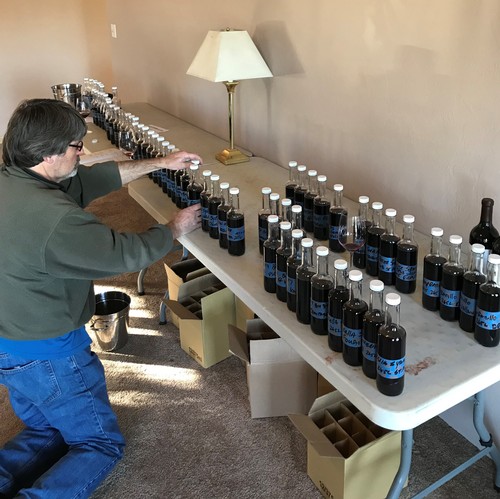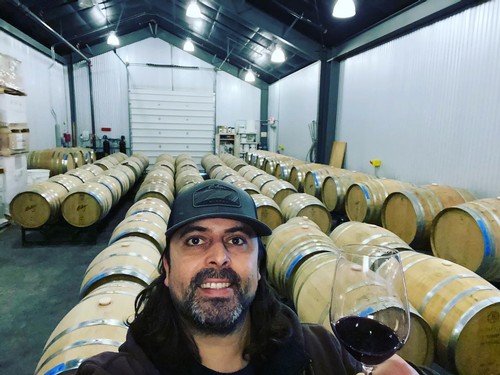NOTES FROM THE CELLAR: BLENDING THE 2019 RED WINES
Is it possible to have back to back stellar vintages? Well…for us we think we really did! Now it is up to us to make sure that 2019 knocks it out of the park just as much as we believe 2018 did. Y’all haven’t had a chance to taste any of these just yet but be ready to have your socks knocked off!
One would think that when we sit down to taste and blend wines it would be a dream, well, it is! Haha! Except that it can also be stressful at the same time. By this time, we are deciding how to really nail the finished wines and what combination of barrels and varieties to use to make that final wine truly sing. In the end, it is not only about what we think the best and most delicious wine is but also if it is a wine that represents what we do at Caliza and one that our loyal members, supporters, and future consumers will enjoy. The anxiety is driven by not knowing how the wine will be perceived by others…we know we love the wine, but will you?
Yes, getting to taste through, give or take, 100 different barrels and aging vessels is a lot of fun and truly very interesting. We age wines in many different types of barrels: new, neutral, 225L all the way up to 500L barrels, and concrete (we also use stainless steel barrels, but those are for white and rose wines). It is amazing how the same lot of wine that was fermented and pressed off into the same tank can taste so drastically different once barreled down, even when put into the exact same barrel from the same cooper with the same toast level and age of the barrel. The culmination of all these unique intricacies is what allows us to deliver unique and fascinating wines with great complexity and character.
We blend in two steps: 1) the initial blend of the core components of the wine and 2) final blending just before bottling with minor tweaks/additions here or there. The initial blend is done in the early Spring of the subsequent year that the wine was made (2018 red wines are initially blended in March-April of 2019). Blends are finalized approximately 12 months later (so 2018 reds in the Spring of 2020) and then bottled shortly thereafter. This dual process allows the wine to show us where it wants to go; it is our job to guide it to the finish line. Sometimes the initial blend is what we end up bottling, it matures so gracefully that as we revisit it over time it just comes together perfectly. Truly wonderful. Sometimes we go through 5, 10, 15 or more final trial blends before we are satisfied with the results. Every year is different, every year is unique.
Now for the process:
- During harvest, all the fruit is hand-picked, brought to the winery to be hand-sorted, destemmed (or not if doing some whole cluster lots) and dumped into fermenters. At this point we begin to develop a sense of where each lot of wine is headed. In 2019 we had 28 separate red lots which we fermented on their own and one co-fermented lot of Cabernet Sauvignon from Arbor Oaks Vineyard and Syrah (Alban clone 1) from the Caliza Estate. It is a lot more work to keep all the lots separate, but it gives us greater availability during the blending process to make changes to a wine in order to add something to the blend that might not otherwise be present (more finish, maybe some mid-palate, added tannin for structure, things like that). We are constantly tasting; tasting the grapes before harvest, tasting them after harvested during processing/sorting, tasting the juice before inoculating (starting fermentation), during fermentation, free-run wine, pressed wine, wine when barreling down before malolactic (ml) or secondary fermentation (more a conversion than fermentation, but that is another story), wine after ml, and then every 6-8 weeks thereafter until the wine is bottled. Phew, is that enough tasting? Then we will taste, re-taste, and taste again when blending. Better make sure to bring your toothbrush or you will look like the character Tia Dalma, the sea goddess Calypso in human form straight out of the Pirates of the Caribbean movies. LOL!

- All the while tasting we are making predeterminations of where certain lots will fit. Some are easier than others. Tempranillo for instance is typically reserved for Sympatico (although you will see it in other wines from time to time), Petite Sirah for Cohort. However, some are a little trickier. Our Syrah for instance, you would probably think “uh it’s all Syrah so that would be easy, right?” Well, we farm 6 different clones of Syrah, we pick them at different times, we might pick the top of a block and then come back and pick the bottom, pick the west side of the block then come back a few days later and pick the east. It gives us differentiating lots within a larger lot (for instance, in 2019 we had 4 separate picks on the 383 Syrah clone, starting at the top of the hill and worked our way down. In 2018 we had two picks on the 174 Syrah clone, west side, and east side). Then we use Syrah in half the wines we produce: Azimuth, Cohort, Companion, Reserve Syrah (in great years), Syrah; it gives us a lot of leeway for where certain clones will go and where others are more fit. For instance, the Estrella clone typically is always a heavy hitter in our Reserve Syrah and Syrah wines where Alban plays well with the Cab in Companion.
- Now to get down to business. Before we can begin our initial blending trials, we must first pull a sample from every single barrel and concrete vessel we have for the vintage. We do not pull composites yet as we want each barrel (sometimes portions of a barrel) to be open for consideration for a particular wine.

- Now we taste through each individual barrel. For me, it is important to jot down notes: observations about the aroma, nose, fruit characteristics, mid-palate, finish, oak impartment, cooperage notes or just anything that might be interesting about the particular barrel I am tasting. Sometimes the notes are long and extensive, other times short and sweet. Being blessed with great memory recall comes in handy when doing a task such as this. Especially after tasting 100, give or take, different samples. Even spitting while tasting you begin to feel the buzz and start asking “when’s lunch?”.
- Then we start to get specific. We say, “which wine are we going to work on?” Say we start with our flagship GSM blend Azimuth. We know we will need to pull forward all Grenache, Mourvèdre, and Syrah barrels as these are the components of this wine. Having tasted each individual piece from the beginning, knowing what clones have traditionally (from past vintages) worked in the blend, we begin with our first trial blend. A few barrels of Mourvèdre, a few Grenache, and one or two Syrah. Blend that trial (200-300ml sample) and taste. Is it all we hoped for? Is it magical? Does it hit it out of the park? Probably not on the first attempt, but we need to get a starting point and have something to build upon. Remember at this point we are really trying to get the core of the wine together and still have time to come back to it at a later point to tweak it. So, we try another combination. Then another. And another. Another. 5 more. Okay, let’s go back to trial #8 and reconfigure to use this barrel of Grenache instead of that barrel, and then add this barrel of Syrah. Around and around, back and forth we go; is this the blend that blows us away? Not quite satisfied we put together trial #18, pour it into each other’s glass, swirl, sniff, swirl, sniff, taste…then the eyes light up. You can actually feel it in the room, the stress is lifted, the intense focus turns to relaxed pleasure, like slumping into a comfy chair after a hard days labor. Tyler looks at me, I look at Carl, we look at each other, that’s it! This is the one!
- We then move on to the next wine and repeat. This initial process always takes the most time; sometimes 5 or more days. We work with great focus and intensity to make sure that the core of each wine is stunning on its own and leave several barrels here and there for us to possibly use for final tweaks before bottling. With experience, you can get a sense of where a wine will go but nobody has a crystal ball that shows you where it will end up. Would it be nice, ya?
2019, much like 2018, gave us another vintage of power and finesse reminiscent to couples dancing an intense contemporary routine. On one side you have the male component: potent fruit flavors, muscular tannins, richness, and density. Then the other side you have the female: intoxicating floral notes, exotic mouthwatering acidity, and layers upon layers of complexity. Blending in years like this is only difficult because you can only use each wine once. After we rack and blend the wines in a tank (rack is defined as moving wine from one vessel to another) we rack them back into the same barrels they came out of for additional aging. At this point we like to come back to them in two weeks just to see how they are integrating at this early stage. We did that just the other day and man…I have to say that you have a lot to look forward to when these beauties get released as they are just phenomenal now! Really looking forward to what is to come with these gems and the back to back Reserve Syrah vintages will be something for the ages for Caliza! Cheers Y’all!!!
